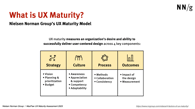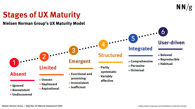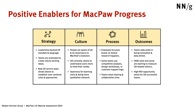MacPaw's UX Maturity Study Conducted by NN/g

- #UX
• 8 min read
This year, MacPaw launched a massive study in collaboration with Nielsen Norman Group (NN/g) to assess our level of UX Maturity. The work is done, and I’m ready to reflect on the process and even share some results.
Why did we seek an external UX Maturity evaluation?
At MacPaw, our mission for the past 15 years has been to help individuals seamlessly interact with technology. Our dedication to user-centric design has earned us praise in the past, as it is vital for the success of any product. However, our ambition doesn't end there. We're committed to elevating and harmonizing the user experience across all of our offerings.
To ensure we not only meet but surpass this goal, we recognized the value of gaining insights from external UX experts. This led to our collaboration with NN/g, the leading expert in the user experience domain.
What is UX Maturity and how is it measured?
According to NN/g, UX maturity is an organization’s desire and ability to deliver user-centered design across 4 key components: strategy, culture, process, and outcomes.

It goes without saying that companies are not equal in terms of their UX maturity. Depending on the results, NN/g’s model differentiates between six stages of UX maturity: absent, limited, emergent, structured, integrated, and user-driven.

Why Nielsen Norman Group’s UX Maturity Model?
Alternatives
There are various methodologies for assessing a company’s UX maturity level:
-
Maze Research Maturity Model: This model outlines five levels of research maturity in organizations, focusing on three main dimensions—People, Process, and Impact. It provides a roadmap for companies to assess and improve their research capabilities, from the skill sets of the team to the influence of research on decision-making.
-
Rolf Molich Model: Grounded in the ISO 33020 standard, this model offers a structured approach to assessing and developing competency in various aspects of UX work. It includes pillars like Analysis, User Requirements, Design, Usability Evaluation, Post-Launch Support, and Standardization.
-
Jared M. Spool Model: This model identifies five stages of UX design maturity within organizations, ranging from the "Dark Ages," where UX is not considered, to "Infused UX Design," where UX expertise is embedded throughout the team. It provides a framework for design leaders to gauge and improve their team's UX maturity.
-
Matthew Godfrey Model: Based on the Design Ladder by the Danish Design Center, this model posits that research is the cornerstone of design maturity. It serves as a guide for organizations to progress in their design practices by focusing on the role and quality of research.
After carefully studying these and other models, we decided to go with Nielsen Norman Group’s UX-Maturity Model, as being the first in the field, NN/g is generally regarded as the gold standard in providing research-based UX guidance. Its founders, Don Norman and Jakob Nielsen, are considered the fathers of UX. It was Don Norman, while working at Apple during Jobs' time, who coined the term User Experience.
In addition to its reputation, our team recognized quality as another factor when making a decision. In today's market, user-friendly products are imperative for profitability. We recognized that NN/g's established methodology, decades of research, and actionable insights would contribute the most on our journey to UX maturity.
How was the UX research conducted?
Nielsen Norman Group conducted an audit on MacPaw's maturity level, and as a result, provided us with recommendations on the changes we need to implement to reach the next level of UX maturity. Yet, of course, it was not as simple as that.
The whole research process took us 6 months. During that time, NN/g analyzed MacPaw artifacts, conducted surveys of macpawians, and held interviews with our leaders and individual contributors. The assessment was led by Kate Kaplan, Insights Architect, and Anna Kaley, Senior UX Specialist.
Test run
Even before starting the formal assessment, we ran a small experiment asking people to participate in a free quiz by NN/g. The results showed significant variation across departments, serving as an early indicator that there are different interpretations and applications of UX practices across our organization.
Data collection
No research can go without data. For this assessment, we collected both quantitative and qualitative data using the following methods:
- thematic analysis of MacPaw artifacts
- interviews with individual specialists in various roles as well as top managers
- internal online survey of specialists
Blockers
The biggest obstacle was war-related. When Ukraine was experiencing the peak of blackouts and air raids due to the full-scale russian invasion, many couldn't attend the interviews. But thankfully things got better and we were able to submit our answers.
Another challenge was engaging the entire MacPaw team, beyond just those involved with UX. Many were unaware of the initiative. Thus, we took steps to educate them on its benefits and emphasize its significance. We utilized some internal marketing strategies to encourage participation in online surveys and gather feedback. To effectively engage hundreds, it's essential to maximize organizational resources and make the participation process as frictionless as possible.
MacPaw UX Maturity Assessment Results
While the score is for internal eyes only, the number is not as important as the understanding behind it. Because we know our baseline, we objectively and clearly see our weaknesses, superpowers, and room for development.
NN/g recognized customer centricity as one of the company’s values and praised the following key achievements:
At a high-level, the idea of customer centricity is accepted and appreciated – due in part to leadership support of this value. The team is highly invested in quantitative methods such as A/B testing, analytics, and surveys as well as market research. Despite the challenges posed by the war, the team's remarkable resilience and determination shine through as they persist and continue to navigate through difficult circumstances.
Different teams within the company are at varying stages of UX maturity. While that's perfectly okay, it does point to some inconsistencies in how we approach processes across departments. What's crucial here is not just knowing where individual teams stand, but understanding our collective maturity level as a company.
Speaking of growth, while there's enthusiasm about incorporating more discovery and qualitative UX research—like user interviews and usability testing—into our product development, it's vital to recognize that this is just the tip of the iceberg. It might seem like a basic recommendation, but the implications are far-reaching and multifaceted.
From a strategic standpoint, integrating such research activities means we are engaging in systematic planning and prioritization, and broadening the roles within the UX landscape. Culturally speaking, this represents a commitment to competency development, advocacy, and raising UX awareness at the organizational level.
On the process front, we're looking to enhance collaborative work, facilitate the exchange of knowledge and insights, and move toward standardizing our UX processes for greater consistency. We're also planning to rigorously assess the impact of these initiatives by focusing on evaluation metrics and ROI.
So, while it may seem intricate and somewhat elusive, getting a nuanced understanding rather than the score alone is what makes all the difference.
Next steps
This was an incredibly important step for MacPaw. After all, we want to grow in the UX sphere, and everyone plays a role in this: even our internal experience affects what we do for our users.
Now, we will work on turning these opportunities into reality, and we have suitable capabilities: leadership mandate, team motivation, exciting ideas, organizational awareness, UX-curiosity, openness for learning, knowledge sharing and collaboration, and pride in data-driven innovation.

The assessment proved that UX-successful teams have a real opportunity for high-ROI products because our users value customer centricity. So our journey is only getting started. Our UX Service and the entire company will continue to build a UX development strategy following a detailed roadmap by NN/g on improving our UX maturity.
Conclusions
In summary, we have successfully undertaken the massive UX Maturity assessment, identifying our current UX baseline and outlining areas for improvement. The benefits are well worth the effort:
- Insightful Overview: We gained a comprehensive understanding of where we stand in the UX realm, backed by expert guidance on scaling to new heights.
- Process Enhancement: This research, a first for MacPaw in 15 years, illuminates avenues for refining our product and service creation processes.
- Team Augmentation: Insights from this assessment can guide our team to perform more efficiently, aligning their efforts with user expectations.
- Trust Amplification: A commitment to UX maturity boosts stakeholder and user trust in MacPaw, solidifying our reputation as a user-centric organization.
- Client Experience Uplift: By understanding and improving our UX maturity, we ensure an enriched experience for the people who use our products.
This project was vital and invaluable for MacPaw. It marked a significant milestone in our 15-year journey, offering clarity on how to optimize our products for our users. We will continue building a culture of delightful user experience.
Subscribe to our blog to follow our journey!





